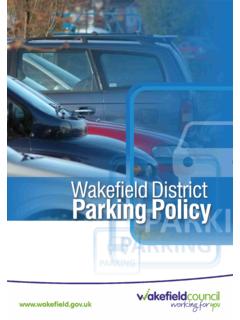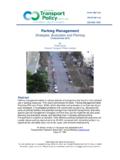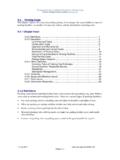Transcription of Trees, Parking and Green Law: Strategies for Sustainability
1 Urban and Community Forestry policy and Law Trees, Parking and Green Law: Strategies for Sustainability February 2004. Prepared by: Kathleen L. Wolf College of Forest Resources, University of Washington Project sponsors: USDA Forest Service, Southern Region Georgia Forestry Commission 5 percent canopy shading 20 percent canopy shading 50 percent canopy shading 60 percent canopy shading Trees and Parking Trees, Parking and Green Law: Strategies for Sustainability February 2004. Prepared by: Kathleen L. Wolf, College of Forest Resources University of Washington Seattle, Washington Project sponsors: USDA Forest Service, Southern Region Southern Center for Urban Forestry Research and Information 320 Green Street Athens, Georgia 30602-2044. Georgia Forestry Commission Urban and Community Forestry 6835 James B. Rivers Memorial Drive Stone Mountain, Georgia 30083. This research and report was funded by: USDA Forest Service, Urban and Community Forestry Financial Assistance Grant.
2 Administered by the Georgia Forestry Commission i Trees and Parking ACKNOWLEDGEMENTS. Appreciation is extended to the following people for their support of, and contributions to this project. Some of the people listed below made suggestions regarding technical content; all content and any errors contained in this report are the responsibility of the author. Ed Macie USDA Forest Service, Southern Region Susan Reisch Georgia Forestry Commission, Urban and Community Forestry Ingrid Sather USDA Forest Service, Southern Center for Urban Forestry Research and Information Rob Crouch City of Portland, Oregon; Parks and Recreation Greg McPherson USDA Forest Service, Center for Urban Forest Research Buck Abbey Louisiana State University, Green Law Research Dudley R. Hartel USDA Forest Service Southern Center for Urban Forestry Research and Information Joe Burgess Georgia Forestry Commission PUBLICATION INFORMATION.
3 Correspondence about this report can be sent to the author at: Copies of this report are available as PDF files at: Citation for report: Wolf, K. L. 2004. Trees, Parking and Green Law: Strategies for Sustainability . Stone Mountain, GA: Georgia Forestry Commission, Urban and Community Forestry. ii Trees and Parking TABLE OF CONTENTS. 1. INTRODUCTION .. 1. Law, Design and Sustainability ---------------------------------------- ------------- 2. Report Purpose and Content--------------------------------- ------------------------ 4. Project Approach ---------------------------------------- ----------------------------- 4. 2. Parking AREAS, TRE ES AND THE URBAN. ENVIR ONMENT ---------------------------------------- ------------- 7. Urban Land Cover and Forests--------------------------------- --------------------- 7. Heat Island Effects ---------------------------------------- --------------------------- 8.
4 Climate Change---------------------------------- ----------------------------------- 11. Air Qualiity ---------------------------------------- --------------------------------- 12. Stormwater Runoff ---------------------------------------- ------------------------- 14. Trees and Social Benefits-------------------------------- -------------------------- 14. Benefits Economics The Synergies of Trees ---------------------------------- 15. 3. policy AND L AW ---------------------------------------- ------- 17. Time and Change ---------------------------------------- --------------------------- 17. Purpose Statements------------------------------ ----------------------------------- 18. The Past - Visual Issues---------------------------------- -------------------------- 19. Expanded Purpose Statements ---------------------------------------- ------------ 21. 4. CODE T RADITI ONS ---------------------------------------- ------ 25.
5 Buffering, Screening and Perimeter Planting ----------------------------------- 25. Interior Landscape------------------------------- ----------------------------------- 27. Vegetation Quantity ---------------------------------------- ------------------------ 30. Variable Landscape Requirements ---------------------------------------- ------- 31. Combining Traditions and Innovations ---------------------------------------- -- 34. 5. Green LAW INNOVATI ONS --------------------------------- 35. Parking Demand and Parking Space Counts ------------------------------------ 36. Flexible Parking Geometry-------------------------------- ------------------------ 37. Tree Preservation and Retention ---------------------------------------- ---------- 39. Tree Canopy Cover----------------------------------- ------------------------------ 41. Plant Specification--------------------------- --------------------------------------- 42.
6 Stormwater Management ---------------------------------------- ------------------ 43. iii Trees and Parking 6. ADDITI ONAL STRATEG IES AND OPPO RTUNIT IES -- 47. Development Plan Review---------------------------------- ----------------------- 47. Trees and Construction---------------------------- --------------------------------- 49. Vegetation Maintenance ---------------------------------------- ------------------- 50. Final Considerations-------------------------- -------------------------------------- 51. Parking Areas Necessity and Nuisance! --------------------------------------- 54. REFERENCE S AND RESOUR CES -------------------------------- 57. Code, Ordinances, Guidelines and Manuals ------------------------------------- 57. Science, Environment and Tree Benefits-------------------------------- --------- 59. APP ENDIX A: SAMPLE PURPOSE STATEMENTS --------- 63. APP ENDIX B: CODE EXAMPLES -------------------------------- 69.
7 Code Traditions ---------------------------------------- ----------------------------- 69. Code Innovations ---------------------------------------- --------------------------- 72. iv Chapter One 1. INTRODUCTION. While the goal of Sustainability is widely accepted, the ways and means of achieving Sustainability in urban areas are still being debated, created and tested. Sustainability is defined in the urban context as practices that do not exceed the environment's capacity to support both human and natural communities, now and in the future including issues of soil, air, water, vegetation and energy. Sustainability can be realized in part through the adoption of innovative legal code. In their efforts to achieve Sustainability , many American cities have reviewed and revised urban forestry, Parking construction and building practices. Communities use Sustainability Strategies that include both comprehensive and detailed approaches to achieve their goals (Portney 2001).
8 Sustainability initiatives vary in scale, depending on the jurisdictional boundaries of a city, county, or metropolitan area. Initiatives may also acknowledge landscape boundaries, such as a watersheds or ecosystems. At the landscape scale, for example, regional governments may team up to construct a transit system, reducing use of non-renewable energy sources. Site-scale practices, such as Green building design, also affect energy use. This report is intended to be a resource tool for concerned citizens and professionals in communities who are acting on one facet of Sustainability - urban Parking lots. The report contains scientific information about environmental impacts of paving in cities, and provides an overview of legal Strategies to reduce those effects. Interested professionals may include planners, landscape architects, engineers and urban foresters. Community volunteers serving on planning commissions or urban forest councils may also find this information helpful.
9 Parking Areas & Sustainability Parking areas are an integral part of the built landscape in American settlements of all scales, from the small town to major metropolitan centers. Parking areas are a landscape cover associated with all zoning and land-use types. Parking lots occupy about 10 percent overall of the land in cities, and can be as much as 20 to 30. percent of downtown core areas Parking lots can occupy as much as 20 to 30 percent of (Beatty 1989). downtown areas 1. Parking areas serve primarily for vehicle storage while people spend time in spaces where they live, work and learn. But Parking areas also reflect American lifestyle trends. For instance, universities now provide more Parking than in the past because of increased numbers of evening and commuting students, and hospitals provide more Parking because of increased short-term out patient care. Parking Area Impacts It is estimated that 80 to 90 percent of all Parking demand is provided by surface Parking lots (Stocks 1983).
10 Typically, two or three times as much space for Parking lots (usually surface lots) is created as there is floor space in the building being served by the Parking . Lots for regional malls can take up more than 50 or 60 acres. Parking space is often viewed by developers as being essential to the market success of commercial buildings. Yet city planners must balance this commercial need for Parking with other community desires such as a more compact urban form, a more pedestrian-oriented urban design and an improved environment. Large surface Parking lots can contribute to drainage and flooding problems, increase urban heat islands, become visual eyesores, and encourage people to abandon mass transit, thereby accentuating Trees and landscaping can reduce paved area impacts air quality problems (McPherson 2001). LAW, DESIGN AND Sustainability . Legal code, ordinances and regulations are important tools that communities can use to encourage, require and enforce sustainable practices.










